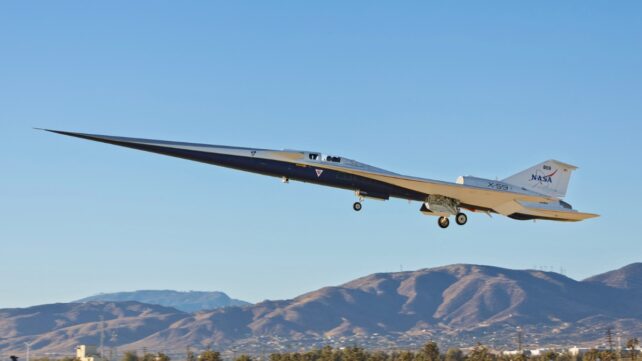In partnership with NASA, Lockheed Martin Skunk Works has executed the first test flight of the X-59 quiet supersonic aircraft.
This week's first flight was subsonic, but eventually the plane will demonstrate technologies aimed at reducing sonic booms to gentle thumps.
"We are thrilled to achieve the first flight of the X-59," OJ Sanchez, Skunk Works' vice president and general manager, said in a news release.
"This aircraft is a testament to the innovation and expertise of our joint team, and we are proud to be at the forefront of quiet supersonic technology development."
Related: Here's What Starship's Successful 11th Test Means For NASA's Moon Mission
Acting NASA Administrator Sean Duffy called the X-59 "a symbol of American ingenuity."
"The American spirit knows no bounds. It's part of our DNA – the desire to go farther, faster and even quieter than anyone has ever gone before," he said. "This work sustains America's place as the leader in aviation and has the potential to change the way the public flies."

The X-59 has been in the works for seven years, and is meant to blaze a trail for low-boom supersonic flight. Commercial supersonic flights over U.S. territory were banned in 1973 due to noise concerns, but in June, a presidential executive order called for lifting the ban.
The spiky X-59 prototype is 99.7 feet (30.4 meters) long with a wingspan of 29.5 feet (9 meters) and an expected top speed of Mach 1.4.
The plane took off from Skunk Works' facility in Palmdale, Calif., at 8:14 am PT October 28 and made a 1-hour, 7-minute flight that ended at nearby Edwards Air Force Base, Aviation Week reported.
Pilot Nils Larson reportedly took the plane to 12,000 feet and conducted basic handling checks at speeds of up to 250 knots while circling the base.
Lockheed Martin said the X-59 "performed exactly as planned, verifying initial flying qualities and air data performance on the way to a safe landing at its new home."
The X-59 has completed its first flight! 🎉✈️
— Lockheed Martin (@LockheedMartin) October 28, 2025
A new era of supersonic flight begins with Skunk Works® and @NASA. pic.twitter.com/iqtNWC6TxJ
The plane's design – including its needle nose, shockwave-smoothing fuselage and top-mounted engine – is meant to minimize the intensity of a sonic boom.
In the months ahead, Skunk Works will continue to lead the initial test campaign, working with NASA to expand the X-59's flight envelope and execute transonic and supersonic test flights. In later stages of the test program, NASA will operate the X-59 to measure its sound signature and gauge community acceptance.
Other companies are already going ahead with their own commercial supersonic projects. Boom Supersonic has conducted faster-than-sound tests of its subscale XB-1 aircraft and is targeting 2027 for the first flight of its full-scale Overture jet.
Boom Supersonic says its jets will cruise high enough to make such flights "boomless" for people on the ground. Meanwhile, Spike Aerospace is developing a low-boom supersonic business jet called the S-512 Diplomat.
Two other startups – Aerion and Exosonic – had been working on concepts for supersonic aircraft but were forced to shut down due to a lack of funding.
This article was originally published by Universe Today. Read the original article.

